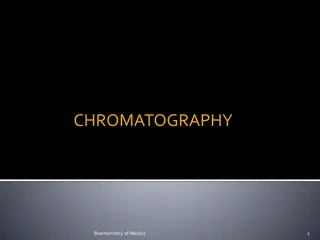Understanding Gel Filtration Chromatography: Principles and Applications
Gel filtration chromatography is a molecular size-based separation technique used to separate macromolecules of different sizes. This method, also known as gel permeation or size exclusion chromatography, utilizes a porous stationary phase where small molecules penetrate all pores and are retained, eluting later than larger molecules. The elution process is characterized by distribution coefficients such as Kd and Kav, with various media like Sephadex being commonly used. Gel filtration chromatography is crucial in biochemistry for purifying and analyzing proteins.
Download Presentation

Please find below an Image/Link to download the presentation.
The content on the website is provided AS IS for your information and personal use only. It may not be sold, licensed, or shared on other websites without obtaining consent from the author. Download presentation by click this link. If you encounter any issues during the download, it is possible that the publisher has removed the file from their server.
E N D
Presentation Transcript
GEL FILTERATION CHROMATOGRAPHY B Y D R R A J E S H K U M A R
INTRODUCTION Gel Filteration is a separation technique which is strictly based on molecular size. It is a helpful method to separate the macromolecule of different sizes from one another. It is also known as Gel permeation, molecular, size exclusion or molecular sieve chromatography. Water is a mobile phase in Gel filtration chromatography whereas organic solvent used as a mobile phase in case of Gel permeation Chromatography.
GENERAL PRINCIPLES Gel permeation chromatography is a special case of partition chromatography because the stationary phase is the same as the mobile phase. The stationary phase is in form of porous when a sample containing solutes varying from small to large molecules elutes through column. Small molecules penetrate all pores and are retained, thus being eluted later than large molecules, which move only in mobile phase. Molecules of intermediate size penetrate only some pores, thereby being retained to a laser degree than small ones. The elution of the solute is best characterized by a distribution coefficient, Kd. Kd = Vo Ve/Vs Kd = Volume of solvent required to elute an unretained compound; also called " void volume''. Ve = Volume of the mobile phase required to elute a compound from the chromatographic column. Vs = Volume of the stationary phase. The Distribution Coefficient. Kav = Ve Vo/ Vt Vo Vt = Volume of the chromatographic column
TYPES OF MEDIA The best-known media for gel-filtration are based on dextran, a polymer of glucose cross-linked with epichlorohydrin. These are called Sephadex. The degree of swelling 1s determined by the degree of cross-linking: others include agarose-base, such as Sepharose and mixed typed [agarose + polyacrylamide]. Sephacryl.
(i) Sephadex: The Sephadex types are designated by G, followed by a number which corresponds to ten times the water regains, the number of millimeters of water taken by 1 gm of dry gel matrix. Thus, the commercially available series: Sephadex G-10, G- 15, G-25, G-50, G-100, G-200 have fractionation ranges for proteins of molecular weights up to 600,000 Daltons. It also swell in organic solvent such as dimethyl sulphoxide ,formamide ,dimethly formamide and mixtures of lower alcohols with. However, the degree of swelling in organic solvents. Sephadex also swells in organic solvents such as dimethyl sulphoxide, formamide, dimethyl formamide and mixtures of lower alcohols with water. However, the degree of swelling in these organic solvents or their mixtures is less than in water alone. The Sephadex series, LH-20, LH-60 and Sephacryl are suitable for organic solvents. SEPHADEX LH types are specially prepared for gel filtration in organic solvents. These are prepared by the hydroxy- propagation of Sephadex G-50. The is have both hydrophilic and lipophilic properties.
(ii) Sepharose: This gel 1s based on agarose, it is used mostly for the fractionation of large molecules. The agarose base is obtained by the purification of agar devoid of charged polysaccharides. The polysaccharide chains in agarose consist of D-galactose and 3,6 anhydro-L-galactose forming double helices like DNA which aggregate on ageing to form bundles. These bundles are mechanically strong with pore size capable of fractionating macromolecules of molecular weight, approx. 1 x 10" Daltons. (iii) Seph acryl: This is an example of a mixed gel, (agarose and poly- acrylamide). The agarose forms a support frame for the polyacrylamide gel. It is prepared by covalently cross-linking allyl dextron with N! N! - methylene bis acrylamide to give a rigid gel with a carefully controlled range of pore size.
S No. Types of Sephadex Fractionation range for Peptides and globular proteins, MW(Daltons) Water Regain Gm Water/gm Dry Gel Bed Volume Cm./gm. Dry Gel Types of Bio-gel Fractionation Range (Dalton) 1 G-10 Up to 700 1.0 2.0 P -2 100-1800 2 G-15 Up to 1500 1.5 3.0 P -4 800-4000 3 G-25 1000-5000 2.5 5.0 P -6 1000-6000 4 G-50 1500-30000 5.0 10.0 P -10 1500-20000 5 G-75 3000-70000 7.5 12-15 P -30 2500-40000 6 G-100 4000-150000 10.0 15-20 P -60 3000-60000 7 G-150 5000-450000 15.0 12-30 P- 100 5000-100000 8 G-200 5000-800000 20.0 30-40 P- 150 15000-150000
Type Approximate Agarose Concentration In %(w/v) Approximate Exclusion Mol. Wt.(Daltons) Sepharrose-2B 2 Polysaccharides Protein Sepharrose-4B 4 20 X 106 40 X 106 Sepharrose-6B 6 1 X 106 4 X 106
CHARACTERISTICS OF GEL MATRIX The characteristics of such gels are enumerated below: (a) Chemically inert: The gel matrix should be inert. Any chemical interaction between the matrix and solutes may lead to irreversible binding to the gel material and chemical alterations of labile substances. (b) Stability: The matrix must be stable over a wide range of pH and temperature. (c) Controlled particle size and size distribution: The particle-size must possess good flow rate characteristics. Therefore, it is essential that the particle size distribution be as narrow as possible. (d) Mechanically rigid: This is essential for the gel particles, so as to prevent deformation by the forces caused by the flow of liquid (solvent)
APPLICATIONS OF GEL PERMEATION CHROMATOGRAPHY There are many different applications of gel permeation chromatography. These have been employed in biomedical research problems and clinical laboratory. These include: (i) separation of polysaccharides, enzymes, antibodies and other proteins. (ii) separation of nonpolar species such as triglycerides in non-aqueous mobile phases. (iii) desalting process i.e., removal of salt and buffer ions from protein solutions as an alternative to dialysis. (iv) phenol removal from nucleic acid preparations. (v) removal of products, viz., co-tactors and inhibitors from enzymes.






















